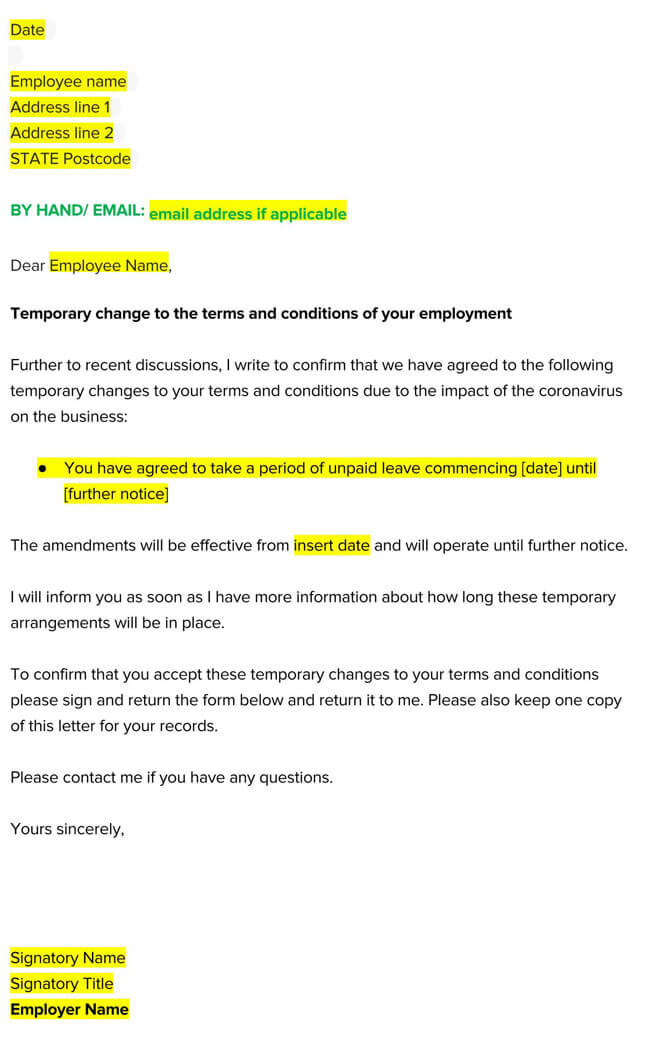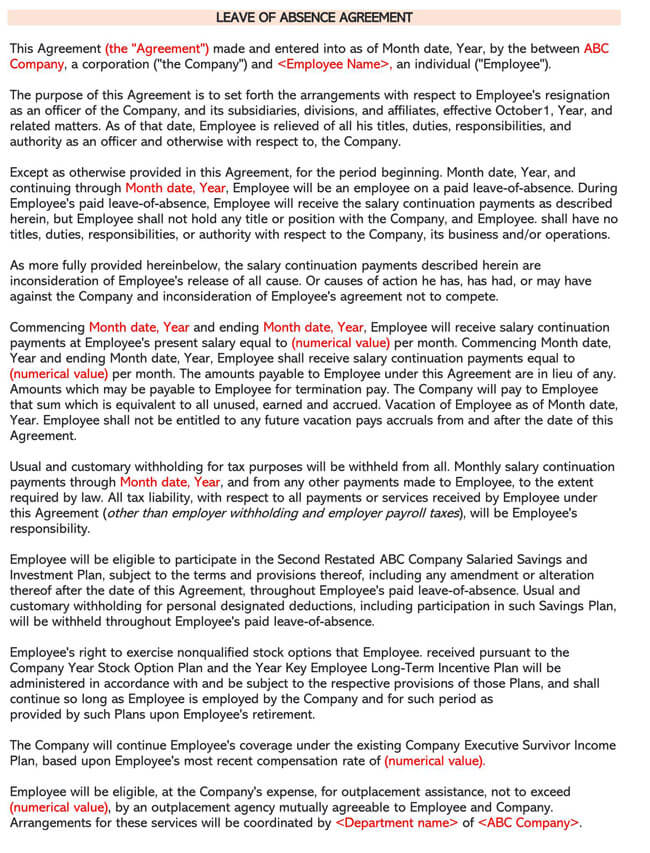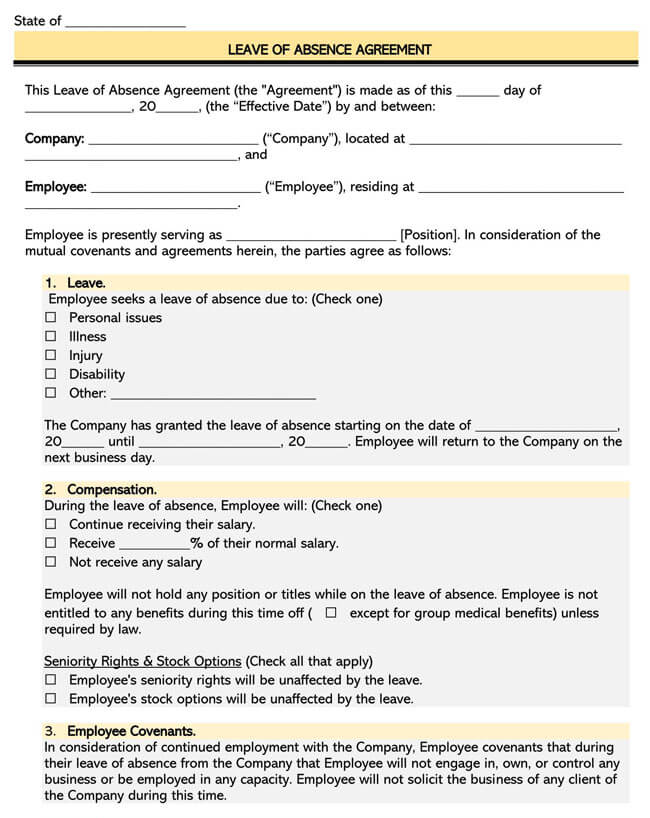Both formal and informal relationships impact workplace productivity. Unexpected family emergencies and other disruptive events may happen to employees. It is a good business ethic to ensure that your business takes emergencies into account as they may warrant that you grant your employees leave of absence at some point. By making your workforce aware of your business’ stance on the requirements for granting employees leave of absence, you will be able to prepare your business better for emergencies. Also, your employee will know what to do or expect when situations that may require temporarily leaving their duty post arise.
Employees may have one reason or the other to warrant their absence from work for a limited period. This could be due to health or the death of a loved one. During such situations, the employee might request a leave of absence agreement. Employers grant their employees leave based on company-established guidelines for granting the leave. There are times when employers may favor using their discretion instead of already established regulations.
So, by definition;
A leave of absence is an official agreement between employees and their employers. It states the requirements for seeking and granting permission to be absent from duty post for a specific period.
Other Names
Leave of absence may also be called other names as listed below:
- Leave of Absence for Employment
- Agreement for Employment Leave of Absence
- Leave of Absence for work
- Agreement for Leave of Absence
- Leave of Absence for Job
Free Templates



Applicable Laws
The Family and Medical Leave Act (FMLA) grants 12 weeks‘ leave to employees who have put in a minimum of 1,250 hours of work to their employers. The 12 weeks leave is to be used to attend to medical emergencies or family responsibilities such as the birth or adoption of a child. During the leave, the employer is not required to pay the employee, however, the employee retains the job. The employee is expected to resume the job description after the 12 weeks elapses. As such, the employer cannot fire the employee during the 12 weeks leave.
Types of Leave
Leave of Absence can be classified into two main categories: Extended and Intermittent Leave. This classification is based on the duration of the leave.
These categories are explained as:
Extended leave
Leave of Absence that spans several weeks or months is regarded as Extended Leave.
This type of leave is often given when an employee is in an emergency involving the life of a closely related family. For example, the death of a spouse, the birth of a child, the need to arrange for parents’ estate after their demise. Employers may also add other situations that qualify for an Extended Leave at their discretion.
Intermittent leave
An Intermittent Leave refers to the reduction of working hours as a result of certain conditions that are permitted by the law and business.
Intermittent leave may be sought by employees when taking on-the-job training or during convalescence. For instance, an employee who is currently taking a training course may request some hours off work to allow him or her to concentrate better during training sessions. Also, an employee who is just recovering from cancer may ask for a reduction in work hours during the recovery period.
Employers may request evidence of training or a doctor’s report before intermittent leave can be granted. Employees may also be asked to show evidence of progress in whatever situation that warranted the leave. Often, an intermittent leave could take between one week and six months.
Terms and Conditions
Employers and their employees need to clearly understand the terms and conditions for taking the leave. This will prevent unnecessary inconveniences and help employees see the emphatic side of their employers.
These terms and conditions are as:
Validity of agreement
The validity of the leave is often time-bound. The agreement is valid if the employee complies with the start date and end date specified in the document. Also, when the extra requirements requested by the employer are provided by the employee, the agreement remains valid. On the other hand, if the employee breaches any of the terms of the agreement, the agreement is rendered invalid.
Expectations about employees
Employees may be expected to inform the employer of the intention to take a leave a month before the start date. In case of emergencies, some companies may allow a 24-hour timeframe for the employee to communicate his or her need for leave. The employee may also be required to have worked certain hours and have some outstanding vacation days. Employees may need to talk to the HR department to find out what is expected of them when processing the leave.
Required documentations
For self-care leave, the employer may request periodic medical reports of the employee to ascertain when the employee can be deemed fit to resume work. An employee who is taking a course may be required to show evidence of admission and class attendance.
Competency or proficiency testing
Employees who are furthering their education may be asked to show semester results or preliminary certificates to qualify for a leave.
Other conditions
The employer can include other conditions that employees must fulfill before they can apply for a leave. For example, a recommendation letter from the head of department or supervisor.
Things to be Added in the Agreement
A template should include some major items. These items set the framework on which the agreement is built. The items listed below are essential for any Leave of Absence template. It is better to add some other items that you find important due to the nature of your business.
However, here, we give a basic outline:
Dates of leave
Specific start dates and end dates are required for both extended and intermittent leave. For intermittent leave, the employer may allow the leave to cover the entire period of training in the case of further education. However, a specific duration may be set temporarily for convalescence as the period can differ widely. Employers should also state if the extension date of leave would be considered under special circumstances.
Extension details of the leave
The general conditions that may warrant the extension of the leave should be stated expressly. For instance, if an employee is still in recovery after the initial leave date has elapsed, the option for leave extension and the requirements should be clear.
The following mentioned details are needed to be added in the agreement:
How it should be requested
To request an extension for the leave, there has to be an agreed means of communication through which the employee declares the intention to seek a leave extension. Some employees allow only written requests. Some permit other forms of communication.
Timeframe
Just as the main leave had a timeframe, the leave extension should also have a specific start and end date.
Parties of extension
Apart from the employer, there have to be other people who need to be aware of the loan extension. Notifications could be sent to the head of the unit or supervisors on the job.
Specific conditions
Conditions such as how the vacant duty post is managed during the period of leave extension must be addressed. Employers must also state if leave extension will come with or without pay.
Resignation
Is there a possibility that the extended leave may put the employee in a position where he or she may be asked to resign? What happens if the employee cannot still resume work after the end date of the leave extension period?
Modifications
Will there be any changes to the job description of the employee as a result of seeking a leave extension? This is critical especially if the employee concerned holds a prominent role in the daily activities of the business.
Other details regarding leave
In the template, the employer may also add the following:
- If the employee is required to give progress reports on training at regular intervals.
- Should the sick employee provide a doctor’s statement on health status with specific comments about fitness to resume the duty post?
- What consequences await an employee who fails to honor the terms and conditions of the agreement?
Details about benefits
The agreement should state clearly who will be responsible for certain benefits during the leave:
- Must the employee exhaust paid vacation and sick leave before requesting a leave extension?
- Will the employee be paid during vacation and sick leave?
- Will the pay rate during the leave remain the same as the regular rate or not?
- Does the employee qualify for disability, life, and health insurance?
- Who will be responsible for the bills, and what percentage?
- Does the leave have an impact on the employee’s pension?
- How is the employee expected to pay part of the benefits where applicable?
- Will there be consequences if the employee does not pay his or her part of the benefits?
Details about the job position
The agreement should specify what happens to the job position of the employee during the period of absence.
Will the employer be the one to stand in for the employee who is on leave?
The agreement should also specify if there is a possibility that the former position of the employee may no longer be available upon the employee’s return from leave.
If the position will no longer be available, alternative resolutions should be specified. For example, the returning employee may be given another job position without writing an application.
Usual Reasons of Leave
There are some common situations where employers are required to issue their employees the leave. These situations include both those protected by labor laws and those that employers give as a show of goodwill but are not protected by law.
Reasons that are protected by law
Labor laws differ from country to country and among states. However, some reasons that may warrant requesting a leave of absence include:
- Birth/adoption of a child
- Placing a child in foster care
- When an employee is dealing with a serious health challenge
Emergencies arising from an employee’s close family or duty status.
Reasons that are not protected by law
The following situations are not protected by US labor laws but employers may grant leave of absence at their discretion:
- Taking in-service training
- Taking short courses for about one semester
- Mourning the loss of a closely related family member
- Spending more time with kids during summer
- Handling parent’s estate after their demise
- Caring for friends and relatives not covered under the FMLA.
Consequences of Not Having a Leave of Absence Agreement
Not having this leave especially when it is needed can cause a lot of discomfort for both employees and their employers. Daily business operations may be affected by the absence of a single key employee, hence, the employer may also suffer the consequences of not having the agreement.
Such a consequences are as:
No job guarantee
Employees who go on leave without a signed agreement are not guaranteed job security when they resume. Labor laws everywhere acknowledge the legal status of the agreement. In case the employee’s position is threatened as a result of obtaining a leave of absence, the employee can seek redress in court over the employer’s actions. Where no agreement was signed, it will be almost impossible to file a case against the employee.
Unintended consequences
The absence of an employee from the duty post without proper authorization can cause a business much more than anticipated. Businesses have lost key customers as a result of the absence of key members of staff at critical moments. To forestall such occurrences, proper arrangements are needed to keep all members of staff on the same page.
Disputes
Where there is no formal arrangement for taking the leave, employees may fall out of favor with their employers for taking some time off work. Disputes of various degrees may arise in the organization as the employer or top executives may begin to tag some employees as being lazy. Such disputes can snowball into abuses and confrontations if left unchecked.
Frequently Asked Questions
During unpaid leave, the employee retains the job position but is not paid during the leave period. U.S employees are permitted to take unpaid leave to take care of themselves or family emergencies. Unpaid leave can also be taken to participate in community services when mandated by the jury. Employers grant the unpaid leave at their discretion.
You can ask your employees to take an unpaid leave when the employee is bereaved of either of the parents. Employees who have a doctor’s report indicating the need for a leave can also be considered. Employers may also grant unpaid leave to employees who recently exhausted the compulsory leave outlined under the FMLA but need more time off.
Having your employees fill and sign a Leave of Absence protects both parties from conflicts and litigations which are bad for a business. It also ensures that businesses run smoothly regardless of certain emergencies.












